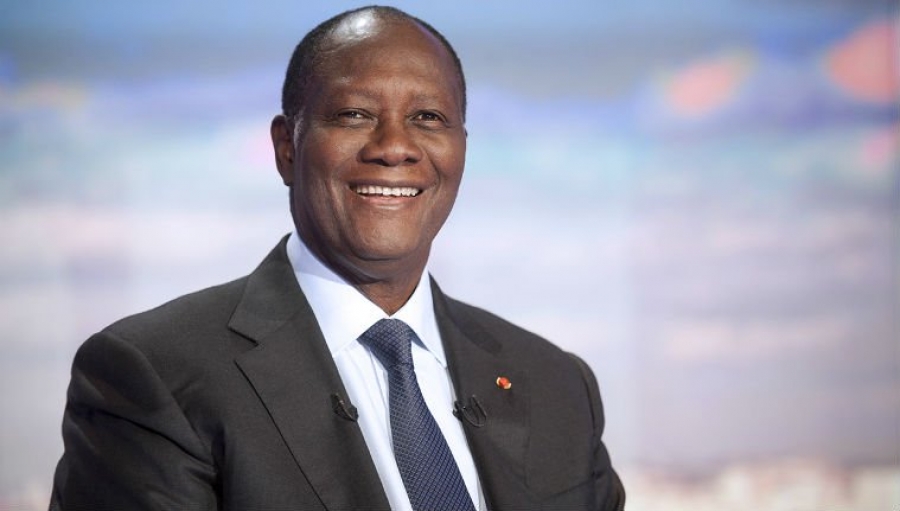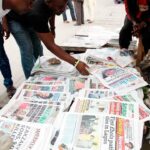The controversial election of Ivorian President Alassane Ouattara for a third term a fortnight ago has created a serious crisis in the West African country. Ouattara stood for the October 31, 2020, presidential election despite the loud outcry by the opposition and civil society organisations against his candidature as he was completing his constitutionally-approved two-term tenure as president. Ouattara, who became president in 2011, had ruled out standing for re-election, but in August 2020 he changed his mind after the sudden death of his party’s candidate, Amadou Gon Coulibaly, in July 2020.
Signs of violence began to manifest before the election as many persons were killed in clashes between pro-Ouattara and anti-Ouattara elements. At least 16 people lost their lives in the inter-communal violence that erupted in Southern Cote d’Ivoire, while several persons, who opposed his candidature, were killed by security forces. After his election, protests continued leading to the death of some 12 persons. Due to the escalating violence, thousands of Ivorians have migrated to neighbouring countries.
The United Nations High Commission for Refugees (UNHCR) spokesman, Boris Cheshirkov, described the situation as very worrying. He said, “In a 24-hour period, we registered 1,000 refugees coming into Liberia. That is for a total of 2,600, some of those people have come into the country in the days preceding the election. So, what we are doing is we are working closely with the government of Liberia but also Ghana and Togo on contingency plans should the situation worsen and should more people start to come across the border.”
- 2023 Poll: UN Deputy Secretary-General charges women to succeed Buhari
- I want to succeed Buhari in 2023 — Tunde Bakare
The situation was so grave that Cheshirkov warned that the election had triggered violence not seen in Ivory Coast since 2011, raising fears that the current situation could spark another conflict. “We know that people are looking back to 2010-11; that period when there was violence, which at that time led to 3,000 dead, more than 300,000 refugees fleeing in the region, and around one million displaced,” he said.
Ouattara’s decision to contest the election has brought an anti-climax to his highly favoured leadership in the West African country. In 2010, local and international opinions, constitutionality and morality were on his side for the presidency. He became the darling of international donor agencies, and the rapid foreign investment in Cote d’Ivoire boosted the country’s economy. Unfortunately, Ouattara has descended into the mud in which former President Laurent Gbagbo fell in 2010; a fall into infamy and conviction for human rights abuses at the International Criminal Court in The Hague.
To save Cote d’Ivoire and the West African sub-region, we call on Alassane Ouattara to respect the will of the people who have taken to the streets over his controversial victory. The opposition is calling for the formation of a ‘Council of National Transition’, which should prepare a framework for a fair, transparent and inclusive presidential election. The opposition recommended that the transitional council should be led by Henri Konan Bedie, 86-year-old former president of the country.
We urge Cote d’Ivoire’s security forces to halt the current harassment and arrest of opposition leaders who have raised their voices against Ouattara’s illegality. We also call on the international community to, in clear terms, condemn Ouattara’s election for an unconstitutional third term and insist on a transparent process in the transfer of political power to a genuinely elected leader. This has become imperative to avert the security and refugee crises that are building up in the West African sub-region.
In the last three decades, the sub-region suffered greatly due to political violence that led to outright civil war in Liberia and Sierra Leone. With the economic downturn in all countries in the sub-region, it would be near-impossible for Cote d’Ivoire’s neighbours to carry the burden that would spillover from the unnecessary, difficult situation that Ouattara’s inordinate ambition would plunge Cote d’Ivoire into.
Well-meaning members of Ouattara’s party, elements in the internal opposition and civil society should work together to reach a consensus on how to prevent the looming catastrophe in Cote d’Ivoire.
released the “Report on the Restitution of African Cultural Heritage: Toward a New Relational Ethic”, which argued that unlawfully acquired cultural property be returned to its lawful owners. The market reacted swiftly: that year, auction houses sold 40% less in the “Tribal Art Market” category than in the year before.
But it is still possible to purchase Nok terracottas in Paris. In fact, it is easy.
For more than 100 years, the Saint-Germain-des-Prés district of Paris has been a global hub for trade with antique Africana. In the first half of the 20th century, the European avant-garde marvelled at “primitive negro and tribal art”. as it was called at that time. The artist Picasso lived here and acquired his own collection of African sculptures. Today there are exhibitions worldwide in which his paintings are shown next to African masks and figures. The similarities are no coincidence.
The “Tribal Art” galleries in the suburb continue to do good business. In one shop window, on a pedestal and spot-lit, rests a woman’s head made of clay. It is unmistakably a Nok terracotta. The gallery owner quotes €13 000 for the figurine.
The price, he says, is “very attractive”. No, he does not have all the necessary documentation to show exactly where it came from, although there is a certificate of authenticity showing that it is 2 500 years old, together with the results of a thermoluminescence analysis.
Four of six Africana galleries visited at random in Saint-Germain-des-Prés sell Nok terracottas of different sizes and quality. Some are sold without export certificates or proof of provenance, and without scientific analyses to date them. The prices range from €4 000 to €20 000. And if you can’t get to Paris, you can also buy them online (at one point the Barakat Gallery website was selling a Nok sculpture for €225 000).
One of the world’s largest collections of Nok terracottas can be found even further away from Nigeria, in New Haven, a small town on the east coast of the United States. It is home to Yale University, which owns the collection, some of which is displayed at the University Art Gallery on Chapel Street.
But how did they get there? Even the history of these specific Nok terracottas is contentious, and is the subject of considerable controversy within the university. Big names and rich donors are involved, and the university is very protective of its image. The University Art Gallery reacts extremely nervously to a visit and questions by journalists on the subject of Nok.
According to the New Haven Register, one of the oldest daily newspapers in the United States, the Nok terracottas came from the art collection of a man called Bayard Rustin. Rustin was an icon of the civil rights movement, together with the likes of Martin Luther King, but he also spent lots of time in Nigeria in the 1950s and 1960s. It was there that he acquired the terracottas, the newspaper claims.
This is quite possible. Rustin was a friend of Nnamdi Azikiwe, Nigeria’s first president, whom he had met in the United States before Nigeria’s independence, and Azikiwe provided him with Nigerian contacts.
After Rustin’s death, the Nok terracottas came into the possession of entrepreneur Joel Grae and his wife Susanna, who donated the collection to the Yale Art Gallery in 2010. Grae had become rich in the nuclear industry, among other investments.
Some gallery staff at Yale are not convinced by this neat explanation. They say their Nok terracottas come from different collections with different backgrounds. At least three dozen of them are listed by the Gallery as “antiquities and archaeological material with provenance documentation gaps”.
It could even be that some of the Nok figurines are quite young, with their age measured in decades rather than millennia, as they are connected to a convicted forger: a dealer from New York with Senegalese background.
One gallery employee says that the university’s Nok collection has plenty to teach students about “robbery, forgery and corruption”. In 2020, the gallery hired a provenance researcher to clear up some of these mysteries, but that person still has plenty of work to do to find out about the true origins of the objects.
The internet makes the process of tracking down the provenance of cultural artefacts a little easier. But it can be a curse at the same time, says Sophie Delepierre. She works for the International Council of Museums, based in Paris, which is an umbrella organisation for more than 47,000 museums. She is Belgian and heads the heritage-protection and capacity-building department.
On the one hand, online databases bring more transparency. On the other hand, the online platforms are “a new nightmare”. Nobody can provide a complete overview of these “superfast businesses worldwide”. Therefore, she says, online markets such as Ebay must be responsible for what they trade — just as with ivory.
In the year 2000, her department for the first time published its “Red List”, which specifies art and artefacts in which trade is restricted or illegal. The list came into existence through a collaboration with Unesco, the World Customs Organisation and Interpol. “The list does not show single stolen pieces, but objects which stand for a whole problematic context, for instance, the Nok terracotta,” says Delepierre.
The existence of the Red List means that dealers, collectors and museums cannot plead ignorance: they know that all Nok terracottas need export certificates and authorisations from their country of origin. So they cannot be surprised when they are later asked to return the object or provide restitution.
“The Red List hangs all around the world like a red flag in airports, police stations and at customs,” Delepierre says. But the illegal art market reacts very flexibly to prohibitions, with new trading routes, clever transport methods and sophisticated fake documents. “We should not be naive. We live in a market economy organised world, and museums are also an industry,” Delepierre adds.
Did her employer, the International Council of Museums, ever kick out a member for unethical behaviour? “Not as far as I know,” she says.
Concluded
Culled from Mail&Guardian.

 Join Daily Trust WhatsApp Community For Quick Access To News and Happenings Around You.
Join Daily Trust WhatsApp Community For Quick Access To News and Happenings Around You.


